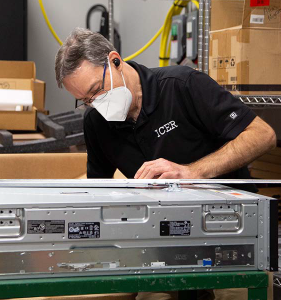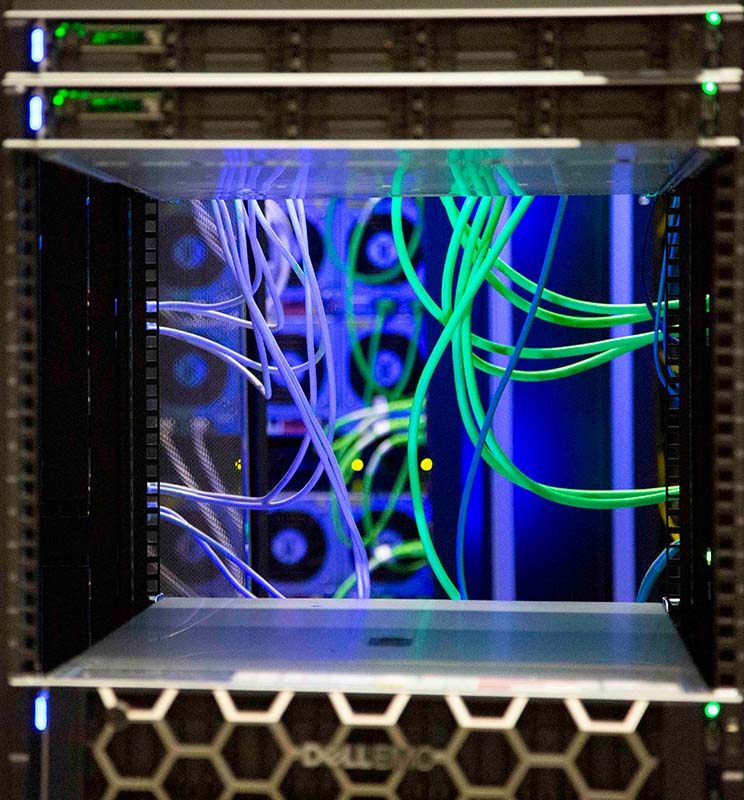A Day in the Life of a System Administrator
Click to watch A Day in the Life of a System Administrator and see inside MSU's supercomputer.
True or false: system administrators are introverts who love caffeine and Szechuan food. “Not actually that far off,” said Kelly Climer, a system administrator for the Institute for Cyber-Enabled Research (ICER) at Michigan State University (MSU). He was quick to add that many system administrators do not fit the stereotypes. ICER communications followed Climer to learn more about his behind-the-scenes profession by experiencing a day in his life.
“A system administrator is someone who keeps the operating system and the programs up and running,” explained Climer. “You have to be tenacious. You have to not be willing to give up, because problems are what we do. The biggest part of our job is solving problems.”
Morning at the Data Center
 After caffeinating with chai tea, the first stop was the data center. This is the building where the supercomputer is housed. The infrastructure of the building is carefully designed to maintain an optimal environment for the massive amount of computing hardware contained within it, including rigorous air quality and temperature control regulations.
After caffeinating with chai tea, the first stop was the data center. This is the building where the supercomputer is housed. The infrastructure of the building is carefully designed to maintain an optimal environment for the massive amount of computing hardware contained within it, including rigorous air quality and temperature control regulations.
Climer, along with fellow ICER system administrator Joe Ryan, MSU undergraduate Richard Ford, and a forklift, installed new graphical processing unit (GPU) nodes in the data center on this day. The cutting-edge hardware makes it possible for computational researchers to get their work done as efficiently as possible.
“That’s what I do,” said Climer. “I want to make sure everyone is up and running as much as possible so that everyone out there has the ability to do what they need to do. Because if I don’t do my job, they can’t do their research. And that’s what I want to facilitate.”
Physically installing the GPU nodes involved preparing and transporting the hardware, positioning the heavy equipment in the racks, and wiring everything together. The ability of the GPU nodes to communicate with each other at super-fast speeds is one of the key factors in making the supercomputer so effective. A cutting-edge node on its own will offer only a fraction of the speedup that is possible when multiple nodes communicate with high-speed connections.
Climer finds satisfaction, and even a bit of a thrill, in applying his skills in this way to help researchers. By keeping the computers running smoothly, he knows he plays a critical role in all of the impactful computational research conducted with ICER’s supercomputer.
Afternoon at the Office
Once the hardware was installed, wired, and all the lights shone in the correct color, the next stop was Climer’s office. After the physical work was complete, he used software on his desktop to make the new nodes available to ICER users. A digital health check indicates when they are working properly.
“We’re providing an environment that, as long as you give it the proper commands, it will provide the output that you’re hoping--well, it will provide the output. It may not be what you’re hoping for. Hopefully, it is!”
Many software-related processes are automated, but system administrators are still required to keep things running as expected. When he is not tinkering with hardware, Climer brings back systems that are down, helps ICER’s research consultants, assists users who are having problems with the systems, creates new user accounts, and does a variety of other essential tasks.
“Sometimes we have hardware failure,” said Climer. “Sometimes software does things that we don’t expect it to do. Sometimes users do things that we don’t expect them to do.”
Climer noted that since he is an end user, meaning the person who is intended to ultimately use a product or service, for other areas in his life, he can empathize with ICER’s end users when they reach out for help.
“I’ve worked with end users since I started with computers,” recounted Climer. “I like helping them out. I understand where they’re coming from because I’m an end user for certain things, too. I have that mindset that I can actually solve these problems for people.”
Evening on the River Trail
 After a full day of installing and fixing hardware and software and helping ICER team members and users, Climer was ready to head home. The last task on his list was picking up his dog, Tucker, from daycare and going for a walk. Strolling along the Red Cedar River, Climer described how he became interested in computers as an undergraduate student at MSU many years ago. He earned his degree in telecommunications and entered the workforce on the technical side of a sales team.
After a full day of installing and fixing hardware and software and helping ICER team members and users, Climer was ready to head home. The last task on his list was picking up his dog, Tucker, from daycare and going for a walk. Strolling along the Red Cedar River, Climer described how he became interested in computers as an undergraduate student at MSU many years ago. He earned his degree in telecommunications and entered the workforce on the technical side of a sales team.
Computers in the office were not commonplace at that time. When Climer showed aptitude with tasks that would be considered basic by today’s standards, like setting up a spreadsheet, he became the computer guy.
“Then, I went into system administration,” explained Climer. “I’m good at it. I enjoy solving problems, and it gives me a wide range of activities I can work on. I really like working with high-performance computing because it is never boring.”
ICER has nine system administrators who each have unique responsibilities to maintain MSU’s supercomputer for computational research across campus. Although their profession is often thought of only when something goes wrong, they are constantly working behind the scenes to update and improve the end-user experience.
